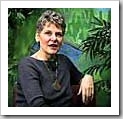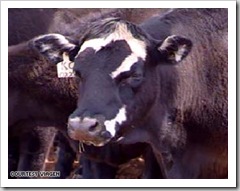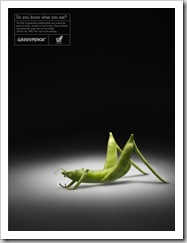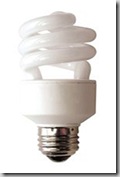This week I wanted to share with you my journey through some natural remedies, what worked and why I began searching for something in the first place. On with my story...
Ever since I was born it seems I've been constipated. Whoops can I blog about this??? Anyway, I used to use all the common and OTC remedies like laxatives, psyllium husks, fiber, prunes, citrate of magnesia, etc. Think I tried them all. Fiber bound me up even more, most laxatives were way to harsh and I never understood the fascination with prunes. Didn't work at all. So I'd go once a week, if lucky, and usually felt miserable. The picture is the little wee me at 3. Awe! Was I ever that young?
In 1986 went to the doctor, he poked and prodded around my abdomen. Couldn't find anything. Suggested some tests. Through ultrasound they found I had gall stones. I was completely asymptomatic but they wanted to take out my gall bladder. Was told that 'I was a ticking time bomb and if I didn't have surgery one day I'd have an attack and may die as a result'. Oh my GAWD!I asked my doctor if there was an alternative to surgery. He said not that he knew of and if I found one he wanted to know. I began searching and found a natural gall stone flush which I did several times. Saw the little green stones in my stool... it worked!Told my doctor about it. He was amazed and said, " I still think you need surgery." Hummm. My conclusion... he was fixated on surgery, rather then the cause of my constipation. Seemed there was nothing else he could offer. So I opted to keep my gall bladder and went on my own personal search to end my constipation. Looked to natural remedies, various colon cleansers and herbal laxatives like Cascara Sagrada. They worked about as well as the OTC I tried, but didn't fix the cause. 
In May 1989 I traveled to Sedona, AZ for a week long healing retreat at the Healing Center of Arizona. I wanted clarification that a decision I made was on target. I wasn't really looking to be healed, rather wanted to experience everything I could. The week was filled with all sorts of treatments, crystal healing, 'Life Healing', massage, veggie diet, acupressure, past life regression, daily walks on the land and nightly dancing. It was a veritable feast of alternative treatments, joy and fun. I met lots of folks who felt like family and felt truly at home. It became clear that my decision was on target. I felt full of energy and purpose. 
Fast forward... January 1992 started a 3 year spiritual journey traveling and camping all over the country without a stationary home. Well you can imagine the effect traveling and camping in the backwoods had... hummm, no private bathroom to sit and cogitate. In early 1993 made a brief stop in Sedona where I met a chiropractor. Told him about my constipation and he suggested a product he sold called ChiroCleanse. I bought a box and tried it... was a miracle! It moisturized the stool, was gentle and effective. The main ingredient was Cassia Angustifolia. But I couldn't find it anywhere else so was still in a bind... so to speak. Blush, ahem.
 On another trip (1994) through Sedona I met a man who had the same difficulty. He used Laci Le Beau Super Dieter's Tea and enemas. I opted for the tea, thank you. It was widely available at health food stores and contained Cassia Angustifolia which I already knew worked for me. Everything was good in my life. I drank a cup of poop tea, as I affectionately began calling it, every night before bed.
On another trip (1994) through Sedona I met a man who had the same difficulty. He used Laci Le Beau Super Dieter's Tea and enemas. I opted for the tea, thank you. It was widely available at health food stores and contained Cassia Angustifolia which I already knew worked for me. Everything was good in my life. I drank a cup of poop tea, as I affectionately began calling it, every night before bed.
Back in Sedona again (early 1995) rented a room for a couple of months from a woman who talked about the value of coffee enemas and green juice fasting. You guessed it! I did a week long fast with daily coffee enemas and poop tea too. Even opted to do another gall stone flush in the process. I felt squeaky clean as a result... but, afterward was still bound up. The only thing I didn't try during all of this was a colonic. 
Fast forward again... in 2004 a friend suggested I read Outlander by Diana Gabaldon. Are you thinking, "What that heck does Outlander have to do with any of this?" Well it was one of the steps that lead me to a solution. In the 'Outlander series', Jamie and his Scottish comrades protest the lack of oatmeal in their diets because they swore it kept  them regular. When I read this a bell went off. I added oatmeal a couple of times a week which made a difference. Then another friend suggested I add ground flaxseed too and sent me some to try. It also made a visible difference.
them regular. When I read this a bell went off. I added oatmeal a couple of times a week which made a difference. Then another friend suggested I add ground flaxseed too and sent me some to try. It also made a visible difference.
In 2006 still doing nightly poop tea and oatmeal with ground flax... I began wondering about long term deleterious effects of the tea on my body. I didn't notice any, but hey 13 years of doing any herb nightly seemed excessive to me. Enter my x-husband, his fiancee, son and great aunt. While they were  staying with me for a couple of days he let me try some ionic minerals which he took daily and swore by. He mentioned that too much gives one loose stool, so gave me a smaller dose. Wow such an effect. I stopped drinking nightly poop tea. I bought some of the same product he suggested online, used it up and started looking for a local source. Ended up buying ConcenTrace Trace Mineral Drops and taking 1/2 teaspoon in orange juice daily. I thought the minerals would be a replacement for the nightly tea and most likely I'd be taking them for the rest of my life. Wrong! After 8 months of taking a daily dose, my body started having reactions after I took it. This was an indication the body had enough so I stopped altogether. I thought I'd have to go back to poop tea again. Joyous surprise... I haven't taken any more tea since.
staying with me for a couple of days he let me try some ionic minerals which he took daily and swore by. He mentioned that too much gives one loose stool, so gave me a smaller dose. Wow such an effect. I stopped drinking nightly poop tea. I bought some of the same product he suggested online, used it up and started looking for a local source. Ended up buying ConcenTrace Trace Mineral Drops and taking 1/2 teaspoon in orange juice daily. I thought the minerals would be a replacement for the nightly tea and most likely I'd be taking them for the rest of my life. Wrong! After 8 months of taking a daily dose, my body started having reactions after I took it. This was an indication the body had enough so I stopped altogether. I thought I'd have to go back to poop tea again. Joyous surprise... I haven't taken any more tea since.
I continue to eat a bowl of oatmeal with ground flax regularly. I haven't been constipated at all. Thank God for small miracles!
Here's a couple of oatmeal/flaxseed recipes I created:
Bonnee's Yummy Breakfast Oats (microwave or stovetop) for 1 serving
1/2 cup regular organic oatmeal, 1 cup filtered water, pinch of sea salt, handful nuts (almonds, pecans, walnuts, etc.), handful pumpkin seed (shelled), handful sunflower seeds (shelled), handful chopped or whole dried fruit (cranberries, raisins, apricots, dates, etc.), 1/4 to 1/3 cup ground flax seeds.
Microwave: Put all ingredients except flax into large microwave safe bowl. Cook 3 to 4 minutes. Add flax, stir and serve with real maple syrup or vanilla almond milk.
Stovetop: In a small stainless steel pot bring water and salt to a boil. Stir in oats cook till soft about 3 minutes. Transfer to serving bowl stir in flax meal, seeds, nuts and dried fruit. Serve with real maple syrup, vanilla almond milk or whatever you like.
Bonnee's WoW Soft Oatmeal Cookies
Bake 350° 11 minutes. Makes about 2 dozen 2" cookies.
1 cup organic whole wheat flour, 1/2 cup ground flax, 1/2 tsp baking soda, 1/2 tsp baking powder, 1/4 tsp salt, 1/4 tsp cinnamon, 1/4 tsp nutmeg, 1/4 lb. (1 stick) organic sweet butter, softened, 3/4 cup packed brown cane sugar, 1 large organic egg, 1/8 cup organic unbleached sugar, 3/4 tsp real vanilla extract, 1-3/4 cup organic oatmeal, 1/2 cup mixed raisins, gogi berries and dried cranberries (softened in hot water and drained) and a handful of each pumpkin seed (shelled), sunflower seed (shelled) and chopped walnuts.
Sift together flour, salt, spices, baking powder and soda. Stir in ground flax seed, set aside. In another bowl cream butter, add sugars and beat until smooth and creamy. Add egg and vanilla, beat until well incorporated. Slowly add sifted flour. Dump in oatmeal, nuts, raisins, and seeds mix to incorporate well. Drop by tablespoon onto Silpat, parchment or greased cookie sheets. Bake 10 to 12 minutes or until lightly brown. Cool 2 minutes on sheet and transfer to cooling rack. Enjoy!
Conclusion: My chronic constipation seemed at least in part to be the result of a mineral deficiency. When the minerals were balanced my chronic constipation was gone. Hope my discoveries and journey were interesting and helpful.
Caveat: Always use discernment with everything in life. Never ingest something to which you are allergic and ask your doctor's advice before trying something new.






